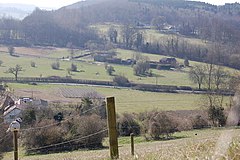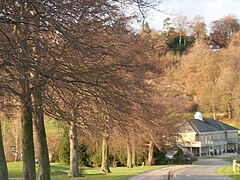Marden Park
| Woldingham | |
|---|---|
 Woldingham Road Woldingham |
|
 Woldingham Golf Club |
|
| Woldingham shown within Surrey | |
| Area | 10.87 km2 (4.20 sq mi) |
| Population | 2,141 (Civil Parish 2011) |
| • Density | 197/km2 (510/sq mi) |
| OS grid reference | TQ369560 |
| • London | 17.5 miles (28.2 km) |
| Civil parish |
|
| District | |
| Shire county | |
| Region | |
| Country | England |
| Sovereign state | United Kingdom |
| Post town | Caterham |
| Postcode district | CR3 |
| Dialling code | 01883 |
| Police | Surrey |
| Fire | Surrey |
| Ambulance | South East Coast |
| EU Parliament | South East England |
| UK Parliament | |
Woldingham is a village and civil parish high on the North Downs in Surrey within the M25, 17.5 miles (28.2 km) south-by-southeast of London; its buildings lie at 150–248m AOD. Situated between Oxted and Warlingham, the village has 2,141 inhabitants. Central London can be reached in 33 minutes by train and the village is served by the Oxted lines. Many of Woldingham's inhabitants work in Croydon or central London, making Woldingham part of the London commuter belt.
Two bronze fibulae, some stone arrow-heads and celts were found here about 1800.
The village lay within the Anglo-Saxon administrative division of Tandridge hundred. It appears in Domesday Book of 1086 as Wallingeham and was held by John from Richard Fitz Gilbert. Its domesday assets were: 1 hide. It had 4½ ploughs. It rendered £1. No church is mentioned in Woldingham in the Domesday Survey. A chapel is first mentioned in 1295 as appurtenant to Gilbert de Clare's part of Woldingham; there has always been a vicar rather than a rector.
Upper Court Manor was owned by a series of high-profile nobles indicating its wealth: including Gilbert de Clare; Ralph, Earl of Stafford; grandson Hugh of Woldingham; Humphrey Earl of Stafford then created first Duke of Buckingham; his third son John, Earl of Wiltshire and son; Edward, Duke of Buckingham, who was attainted and beheaded in 1521 leaving it for Henry VIII to grant; John Bourchier Lord Berners, Deputy of Calais; Sir John Gresham and his family held until sale to Henry Bynes; William Bryant who purchased it for £3,600 in 1795; followed by a Mr Withers, Jones and Gifford.
...
Wikipedia

